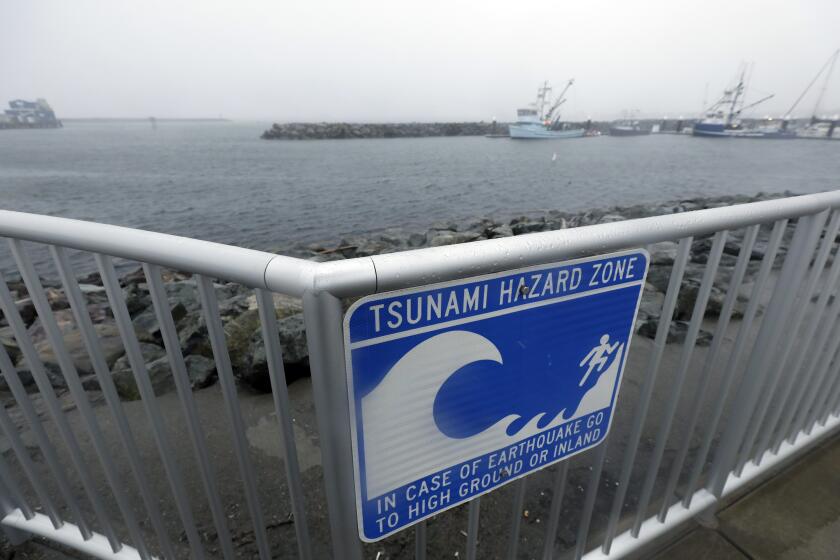Are you at risk of tsunami flooding in Southern California? Check these maps

- Share via
California’s coastal areas are obviously at highest risk from an incoming tsunami. But how far inland does the threat extend?
The answer might surprise you. Tsunami hazard areas can be quite large depending on the location, and in some cases, they are home to large numbers of people.
In Southern California, a large swath of Venice and all of Marina del Rey are in a tsunami hazard area. So are wide sections of Long Beach, including Belmont Shore, Naples Island and the city Convention Center.
Significant segments of Orange County are also at risk. They include Newport Beach’s Balboa Island and Balboa Peninsula, as well as neighborhoods in Sunset Beach and Seal Beach.
A tsunami warning was issued across Northern California on Thursday morning following a magnitude 7 earthquake. It’s a reminder to prepare and know how to respond in case of such emergencies.
Even where tsunami hazard zones are relatively narrow, many Californians may not have the instinct to get to higher ground after the ground shakes.
The Malibu Village mall is separated from the coast by two rows of houses, a golf course and Pacific Coast Highway, yet is still at risk because of its proximity to not just the ocean but also Malibu Lagoon.
And the risk can vary. The tsunami hazard area in Manhattan Beach is essentially limited to the beach and pier on the coastal side of the Strand, the walking-and-biking path that separates the sand from luxury homes. Yet in Hermosa Beach, the tsunami hazard area also covers the pricey homes a block or so east of the trail.
Visiting SeaWorld in San Diego? The theme park is outside the hazard zone, but some hotels and resorts to the west and north are not. Checking out Santa Barbara’s waterfront? There’s no need to flee the city — walking a few blocks inland could be all you need to do to get to safety.
And not all tsunamis will flood the entire hazard zone. If a tsunami is, say, more than four hours away from arriving, officials may be able to issue fine-tuned orders that will limit the scope of the evacuated area. But if a tsunami is coming in a shorter period of time, authorities may decide to simply evacuate the entire zone as a precaution.
Tsunami hazard zones represent the maximum inundation area in a number of extreme yet realistic scenarios, the California Geological Survey says.
If you’re uphill or inland from the zones, you should be safe from any tsunami. That’s why officials say it’s important to know whether you live, work or play in a hazard zone. Experts recommend knowing how you will evacuate and where you need to go.
But if you don’t have prior knowledge of whether you’re in a tsunami hazard zone, and no maps or evacuation signs are available, aim for spots 100 feet above sea level and as far as two miles inland, if possible, officials say.
Coastal areas in Northern California began evacuating residents after a 7.0 earthquake off Humboldt County’s coast prompted a tsunami warning. Luckily, the worst didn’t play out. But emergency procedures were appropriately taken, officials said.
Given geography, density and access, some areas could be particularly challenging to evacuate in the event of an earthquake-spawned tsunami.
“There are places on the U.S. West Coast, and here in Alaska, where an entire safe evacuation for a near-shore event ... would [have] a much lower success rate,” said Dave Snider, the tsunami warning coordinator at the National Tsunami Warning Center in Alaska. “That is the No. 1 reason why people need to understand what their hazard zone is ahead of time.”
An example of a hard-to-evacuate area could be the ports of Los Angeles and Long Beach. But in Laguna Beach, advance knowledge of the tsunami hazard area shows that it’s relatively small, and walking a few blocks away could make a difference.
While rare, a tsunami could arrive just minutes after the earth shakes, depending on the location. Snider said the tsunami warning from last week — issued in the wake of a magnitude 7.0 quake that struck 30 miles off the coast of Humboldt County — is a good reminder that this type of event is a real concern.
“You just experienced a significant alert — one that may never happen again to you,” Snider said. “But in the event that it does … ask yourselves, did I have alerts when I needed them?”
Centered under the Pacific Ocean about 70 miles southwest of Eureka, the strong quake frayed nerves across most of California’s North Coast.
Those who were ordered to leave during last week’s widespread warning should use the experience to assess whether their evacuation plan worked and if they need to change it, Snider said. Those who live in higher-risk areas should also, ideally, have a go-bag ready, he added.
Here are maps showing some of Southern and Central California’s most populated areas within a tsunami hazard zone, as determined by the California Geological Survey. The yellow section indicates the tsunami hazard area.
(Information on the Northern California locations most at risk for flooding from a tsunami can be found here.)
Downtown San Diego and Coronado

Laguna Beach

Newport Beach

Seal Beach and the surrounding area

Long Beach

Redondo Beach and Hermosa Beach

Marina del Rey and Venice

Santa Monica

Malibu

Ventura County


Santa Barbara County


San Luis Obispo County



More to Read
Sign up for Essential California
The most important California stories and recommendations in your inbox every morning.
You may occasionally receive promotional content from the Los Angeles Times.















